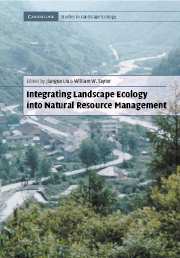Book contents
- Frontmatter
- Contents
- List of contributors
- Foreword
- Preface
- Acknowledgments
- PART I Introduction and concepts
- PART II Landscape structure and multi-scale management
- 2 Integrating landscape structure and scale into natural resource management
- 3 Focal patch landscape studies for wildlife management: Optimizing sampling effort across scales
- 4 Managing for small-patch patterns in human-dominated landscapes: Cultural factors and Corn Belt agriculture
- 5 A landscape approach to managing the biota of streams
- 6 Linking ecological and social scales for natural resource management
- PART III Landscape function and cross-boundary management
- PART IV Landscape change and adaptive management
- PART V Landscape integrity and integrated management
- PART VI Syntheses and perspectives
- Index
- Plate Section
5 - A landscape approach to managing the biota of streams
Published online by Cambridge University Press: 14 January 2010
- Frontmatter
- Contents
- List of contributors
- Foreword
- Preface
- Acknowledgments
- PART I Introduction and concepts
- PART II Landscape structure and multi-scale management
- 2 Integrating landscape structure and scale into natural resource management
- 3 Focal patch landscape studies for wildlife management: Optimizing sampling effort across scales
- 4 Managing for small-patch patterns in human-dominated landscapes: Cultural factors and Corn Belt agriculture
- 5 A landscape approach to managing the biota of streams
- 6 Linking ecological and social scales for natural resource management
- PART III Landscape function and cross-boundary management
- PART IV Landscape change and adaptive management
- PART V Landscape integrity and integrated management
- PART VI Syntheses and perspectives
- Index
- Plate Section
Summary
Introduction
Although landscape ecology is generally considered a terrestrial discipline, ecologists working on streams and rivers have long been interested in the spatial relations and geographical distribution of aquatic organisms and their habitats. In fact, if a landscape is defined as a spatially heterogeneous area, and landscape ecology as the study of its structure, function, and change (Turner, 1989), then landscape ecology has the potential to be an important force in the appropriate management of streams and rivers. The application of landscape ecology to riverine management is particularly well suited to three classes of activities: conservation of biodiversity, fisheries management, and restoration/ rehabilitation of biological integrity.
In this chapter we review relevant stream-ecology concepts that encompass a landscape perspective and link these concepts to current management practices. We argue, with examples, that scale-dependent processes that are valuable to society underlie biotic patterns in streams. We show how recent evidence links certain land-use activities with altered stream condition, and attempt to present the underlying mechanisms responsible. To show the integration of landscape principles with practical management, we present examples related to stream restoration, recreational fishing, and a case study of an ongoing project to prioritize the conservation of aquatic biodiversity on a regional basis.
Landscape elements of stream ecology
Several categories of concepts have been developed to explain how streams function in the context of the landscape (Ward, 1989; Lorenz et al., 1997): concepts that focus on longitudinal changes of the biota; concepts emphasizing lateral interactions; concepts that integrate longitudinal, lateral, and vertical dimensions of streams; and concepts emphasizing spatial hierarchies and temporal changes.
- Type
- Chapter
- Information
- Integrating Landscape Ecology into Natural Resource Management , pp. 114 - 142Publisher: Cambridge University PressPrint publication year: 2002
- 11
- Cited by



